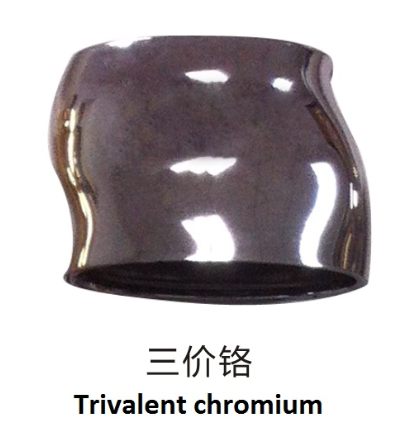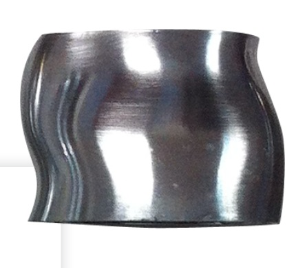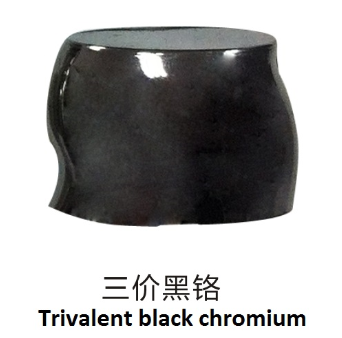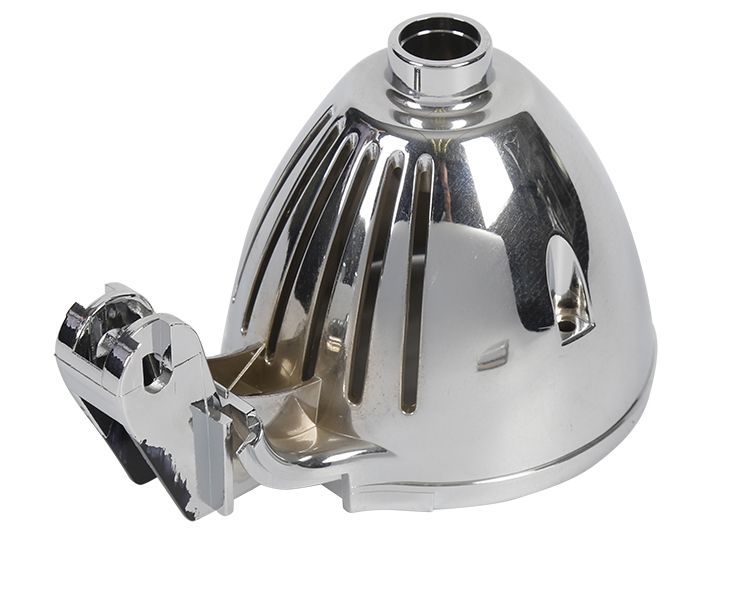1.1 Plating solution composition
The main components of trivalent chromium plating baths currently studied and used are as follows [1].
(1) Main salt: The current trivalent chromium plating system mainly includes chloride system, sulfate system, and sulfate-chloride mixed system.

Chloride plating solution conductive good, low voltage, plating solution dispersion ability, coverage ability, and current efficiency is higher, but the anode will precipitate toxic Cl2, and heavy corrosion of equipment; chromium sulfate plating anode precipitation of non-toxic oxygen, no pollution, but the plating solution conductivity is not as good as chloride, plating solution dispersion ability, coverage ability, and current efficiency is lower.
(2) complexing agent: usually hydroxycarboxylic acid and its salt, such as formic acid and acetate, amino acetic acid, oxalic acid and its salt, citric acid and its salt, thiocyanic acid and tartaric acid salt, etc.
(3) Conductive salts: reduce the consumption of electrical energy. Mostly sodium, potassium, ammonium chloride, and sulfate.
(4) Buffer: maintain the pH stability of the plating solution. Mostly boric acid, acetate, aluminum salts, citrate, etc.
(5) Stabilizer: compound reducing agent, inhibit and reduce the production of hexavalent chromium. Mostly methanol, sodium sulfite, halide, etc.
1.2 Process conditions
(1) Temperature: preferably at room temperature, the working temperature is generally controlled at 15 to 55°C. An increase in temperature will reduce the concentration difference polarization and make the precipitation point of Cr3+ positively shifted, while the precipitation of hydrogen is serious, which is not conducive to the deposition of chromium.
(2)PH value is 1~4. When PH value is low, hydrogen precipitation is serious, cathode current efficiency is reduced, when PH value is high, hydroxyl bridging reaction is easy to occur, and the plating layer is dark.
(3) The current density is 3~100A/dm2. The range of cathode current density is wide, but it will affect the chromium deposition speed when it is low, and the high cathode current density will affect the coating performance.
(4) Current efficiency is 10% to 25%. Slight agitation is possible.
In addition, trivalent chromium plating is available in a single bath method and a double bath method. The anode material in the single bath method is graphite rods, as in another common plating; the double bath method uses an anode inner bath, which allows the use of a lead-tin alloy anode cover, and in addition dilute sulphuric acid is used as the anode base solution.

1.3 Advantages and disadvantages of trivalent chromium plating
Trivalent chromium plating has the following advantages.
(1) Low toxicity and low pollution. The cleaning water of the plating solution does not contain hexavalent chromium and the wastewater can be discharged with minor treatment, and the plating process does not produce toxic chromic acid mist;
(2) Low concentration of plating solution, only 1/10 of hexavalent chromium plating, good dispersion, and coverage ability, improved yield;
(3) The plating process is not affected by the interruption of the current and does not require de-plating;
(4) The cathode current efficiency can reach 21-25%, which is higher than hexavalent chromium plating and improves productivity.
At the same time, trivalent chromium plating has the following problems.
(1) The thickness of the plating layer is difficult to improve, and can only be used for decorative chromium plating, but not for thick chromium plating, and functional chromium plating is difficult;
(2) The plating solution is complex and unstable; the tolerance to impurities is very low and maintenance is difficult;
(3) The choice and use of anodes is inadequate, corrosion resistance, hardness, and impact resistance still need to be improved;
(4) When decorative chrome plating, the appearance of color is not satisfactory.
(5) The investment in primary equipment is large and the cost is high.
Among them, the plating layer thickening problem is the key problem of the development of the trivalent chromium plating process, the influence of trivalent chromium plating layer thickening has the following three views [2].
a. PH influence: the cathode surface with chromium deposition, PH value rises rapidly (PH>8.2), resulting in the generation of chromium hydroxide, and entrapped in the layer, affecting the normal crystallization of chromium plating layer, resulting in the thickening of the layer difficulties.
b. The influence of the presence of Cr3+: the cathode diffusion layer in the process of plating PH value rises (PH ≥ 4), hydrated Cr3+ will occur hydroxyl bridge reaction, the presence of Cr3+ play a catalytic role, so that the hydroxyl bridge reaction quickly, thereby inhibiting the further reaction of chromium precipitation.
c. Influence of cathodic reaction process
With the prolongation of plating time, the PH value and temperature near the cathode surface rise continuously, resulting in the intensification of cathode hydrogen precipitation, the current efficiency of metal deposition is reduced, and the hydroxyl-bridging reaction between OH- and Cr3+ occurs near the cathode, which inhibits chromium deposition.
2 Trivalent chromium plating development history and research status

As early as 1854 Bunsen conducted a study on chromium plating using chromium chloride, but the research progressed slowly due to a large number of problems with the performance of trivalent chromium plating solutions and the quality of the plating.
The hexavalent chromium plating process was the first to enter industrial production since Surgent published an electroplating bath of chromic acid and sulphuric acid in 1923. However, in practice, the hexavalent chromium plating process was found to have many shortcomings: (1) low cathodic current efficiency, generally only 12-15%; (2) poor dispersion and coverage of the plating solution; (3) high-temperature control requirements for chromium plating production; (4) chromium plating process brought out chromic acid and the formation of chromium mist on the environment pollution. This has prompted people to explore the use of the trivalent chromium plating process to replace hexavalent chromium plating.
In the 1970s, Albright & Wilson published the famous Alecra-3 process, and the research on trivalent chromium plating made a breakthrough and entered the practical stage. The process is better than the chromic acid plating solution in terms of dispersion, coverage, and current efficiency, but there are disadvantages such as thin layer thickness, inability to plate hard chromium, lack of good color appearance, unstable plating solution, and sensitivity to impurities.
Since Dr. S. Hoshino and Tokyo City University (TCU) made the trivalent chromium plating solution (HOSHINO plating solution) in 2001, they have been working with Koka to study the applicability of the solution and have achieved some results in small plants using 50-200L.
The HOSHINO electroplating solution uses chloride for trivalent plating and amino acetic acid as a catalyst.

